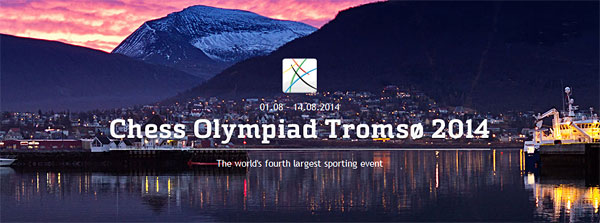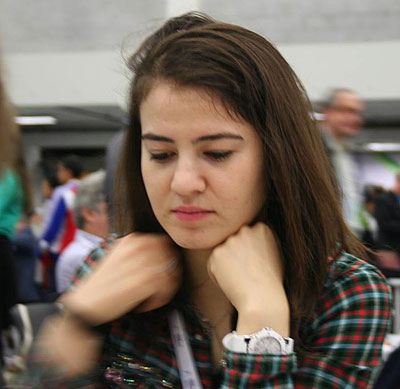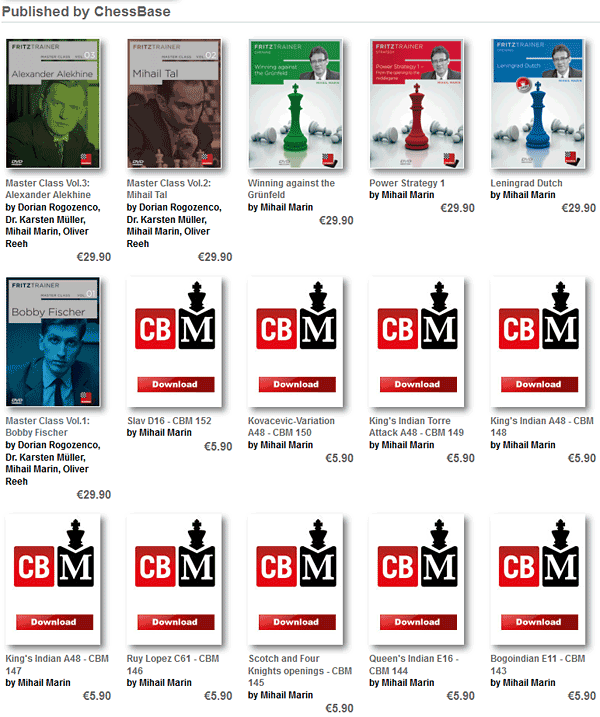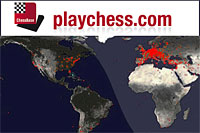
Marin on Tromsø – round eleven selection
In the remote times when ranking second in the national rating list, more or less ensured the selection in the Olympic team, an old-fashioned principle, which may still apply in some countries, but was abolished in Romania – in those years I inevitably was assaulted by nostalgia when finishing the Olympiad's last round game. This wonderful festival, gathering together the most representative players all over the world and allowing one not only to see his (or her) biggest idols from close, but also being raptured by the most daring dreams – this unique experience was over and it would not be before two years that it would open its Wonderland mirrors again. And even if I was confined to follow from afar what I had hoped to be my 12th Olympiad, having written my reports day by day brought up the same familiar feeling once the last round was over. And since I have learned that the best remedy for nostalgia is winning the last game, even though this would not matter too much for the team or individual result, I have taken this as the subjective criteria for the today's selection. Both games below took place relatively far from the medals, but this does not seem to have affected the players' ambitions.
I assume that for the three time gold medalist Armenian team, any other result than a place on the podium would in principle be a big disappointment. But in Tromso, things did not really work out well for the squad headed by Aronian, ranked second in the world hierarchy. For a couple of days already it had become clear that Armenia would have to wait until 2016 to reiterate its quest for the Olympic title. But the last round win over the strong Czech team must have improved the players' mood before packing for the way back home.

Armenian board one Levon Aronian at the start of round eleven

[Event "41st Olympiad Tromso 2014 Open"] [Site "Tromsø"] [Date "2014.08.14"] [Round "11"] [White "Aronian, Levon"] [Black "Navara, David"] [Result "1-0"] [ECO "D10"] [WhiteElo "2805"] [BlackElo "2716"] [Annotator "Marin, Mihail"] [PlyCount "53"] [EventDate "2014.??.??"] [EventCountry "NOR"] [WhiteTeam "Armenia"] [BlackTeam "Czech Republic"] [WhiteTeamCountry "ARM"] [BlackTeamCountry "CZE"] 1. d4 d5 2. c4 c6 3. cxd5 cxd5 {Had it been played one round earlier, this game would have fitted into the "Boring symmetry?" article rather well.} 4. Nc3 Nf6 5. Bf4 Nc6 6. e3 Bf5 {[#]} 7. Qb3 ({The reader may remember that the tenth round game Eljanov-Rauf Mamedov continued with} 7. Rc1 {I cannot know whether Aronian took some inspiration from White's ease at winning that game, but the sure thing is that both players had some experience with this line.}) 7... Na5 {By far the most popular way of dealing with the early pressure against b7.} 8. Qa4+ Bd7 9. Qc2 {This is just the start of a curious mechanism of moving the pieces forth and back all over the board. Optically, this is somewhat confusing, but judged individually all the moves make sense.} e6 {White has managed to force his opponent retreating with his bishop behind the pawn wall, but this caused some delay with the kingside development.} 10. Nf3 ({Playing with black, Aronian had faced} 10. Bd3 {in Kramnik-Aronian, Shanghai 2010.}) 10... Be7 11. Bd3 Nc6 {The knight returns to its usual location, controlling e5 and winning a tempo by threatening ...Nb4 on the way.} 12. a3 Nh5 {A new minor piece dialogue starts on the opposite wing. The f4-bishop is too strong to be tolerated.} 13. Be5 f6 {The only reasonable answer, although is weakens the light squares.} ({If} 13... Nxe5 14. Nxe5 ({Actualy, the standard reaction is} 14. dxe5 {, leaving the h5-knight out of play, but for concrete reasons the main move is even stronger.}) 14... Nf6 15. Nxd7 $1 {White gives up his active knight for the passive bishop light-heartedly, since Black has no satisfactory way of re-capturing.} Nxd7 {Other moves wouldexpose either the queen or the king to Bb5.} 16. Bxh7 g6 ({Or if} 16... Qc7 {as played in Ju-Sebag, Beijing 2013, the simplest would be} 17. g3 {defending the h2-pawn before retreating with the bishop.}) 17. Bxg6 fxg6 18. Qxg6+ Kf8 19. Qxe6 {With a whole bunch of pawns for the piece.}) 14. Bf4 $5 {A new move, deviating from a recent game played by Navara.} ({After} 14. Bg3 f5 15. Be5 O-O 16. h3 Nf6 17. g4 Ne4 { Black seemed to have enough counterplay in Ivan Sokolov-Navara, Saint Quentin 2014, even though later White took over the initiative. With his move, Aronian kindly invites his opponent to take on f4, thus opening the e-file nd turning e6 into a real weakness.}) 14... Rc8 {Navara took his time (13 minutes) before answering.} ({His first impulse might have been the same as mine when playing over the game: what would happen if Black plays the same way as in the aforementioned game:} 14... f5 {The difference is that White could fight for the e5-square with} 15. Bb5 {. With the bishop on g3, Black could have reduced White's influence on dark squares with ...Nxg3, while an exchange on f4 would only increase it.}) 15. h3 {The threat of retreating with the bishop practically forces Black's next move.} Nxf4 16. exf4 Qb6 17. Rd1 {The weakness of the e6-pawn is latent yet, but Black needs to find the best way of defending h7.} f5 {This looks the most solid, but it weakens the e5-square chronically.} ({The main alternative was} 17... g6 {David might have disliked} 18. h4 {when, quite probably, Black could not have been able to refrain from .. .f6-f5 in the long run anyway.}) 18. Bb5 {Immediately starting the fight for the weakened square.} Bd6 19. g3 {[#]} Na5 $6 {A risky decision. Black gives up the right to castle for the sake of exchanging his bad bishop and keeping the knight as an important defender of the e5-square.} ({Any neutral move such as} 19... O-O {would have been safer, although White would have a pleasant position.}) 20. Bxd7+ Kxd7 21. O-O Rhe8 22. Rd3 $5 {An interesting multi-purpose move. White prepares doubling (or even trippling) his major pieces, without revealing whether this would happen on the e-file or on the c-file.} Nc4 {Preventing Re3, just in case this was White's true intention. But now Aronian switches to plan B.} 23. Na4 Qc6 24. Rc3 {[#]} b5 $2 {The losing move, played after only three minutes. Navara obviously wanted to consolidate his active knight, but the weakness of the c5-square ill be a perfect (for White!) complement to that of the e5-square.} ({True, the attempt to get castld artificialy with} 24... Ke7 25. Re1 Kf8 {would fail to} 26. Ng5 { , attacking two pawns.}) ({But it would have made sense to restrict the a4-knight with} 24... b6 {since} 25. b3 $6 {would run into} Nxa3 {White could have prepared b2-b3 with 25.Ra1, but then 25...Qb7 might have made Black's position survivable.}) 25. Nc5+ $1 {The bishop cannot keep both enemy knights under control.} Bxc5 26. Rxc4 $1 {Just two moves earlier, the e5-square was rather well defended, but not any more.} bxc4 27. Ne5+ 1-0
The psychological background of the next game was slightly different. After a hesitating first half of the tournament, the strong USA team fought back with a series of good results. But for the Azeri team, which had been in the lead after seven rounds, the situation before the last round must have been disappointing. As pointed out by Alejandro Ramirez in his last round preview, "Both teams need a combination of results plus their own victory to achieve Bronze; Silver for either looks unlikely." I have learned that in real life a favourable combination of other teams' results belongs to the miracle world, but this did not seem to demotivate either of the teams. As it turned out, Azerbaijan's win sufficed only for a honourable fifth place. And even though defeating his mighty opponent did not yield Shakhriyar Mamedjarov a board medal, it surely improved what was an outstanding personal result anyway.
We do not have a picture handy of Shakhriyar Mamedjarov during the final round, so you are going to have to make do with pictures of his sisters taken during the round. Our apologies...

WGM Zeinab Hamid qizi Mamedyarova, 30, won the silver medal in the
Istanbul Chess Olympiad and a bronze medal in 2002 Olympiad in Bled

WGM Turkan Mamedyarova, 24, and rated 2274, lost her final
round black game against WGM Marta Bartel, rated 2359

[Event "41st Olympiad Tromso 2014 Open"] [Site "Tromsø"] [Date "2014.08.14"] [Round "11"] [White "Mamedyarov, Shakhriyar"] [Black "Nakamura, Hikaru"] [Result "1-0"] [ECO "D10"] [WhiteElo "2743"] [BlackElo "2787"] [Annotator "Marin, Mihail"] [PlyCount "81"] [EventDate "2014.??.??"] [EventCountry "NOR"] [WhiteTeam "Azerbaijan"] [BlackTeam "United States"] [WhiteTeamCountry "AZE"] [BlackTeamCountry "USA"] 1. d4 d5 2. c4 c6 3. Nc3 dxc4 {The reader can breath with relief: no, there will not be another Exchange Slav!} 4. e3 b5 5. a4 b4 6. Ne4 Qd5 7. Nd2 c3 8. Ndf3 $5 {A rare move.} ({The usual continuation is} 8. bxc3) 8... Qa5 ({Now and in the whole next phase of the game, Black refrains from} 8... cxb2 {, which would make the extra pawn look more real, but at the same time allow White's rapid development with} 9. Bxb2 {Over the board and against such an aggressive player like Mamedjarov, it is not easy to embark such a continuation. With hindsight, it is easy to recommend precisely this continuation. But if Nakamura had played like that and lost anyway, commentators may well have criticised him for treating the issue of development so superficially. Only further practice and analysis will show the best way to react.}) 9. Ne5 Nf6 10. Ngf3 e6 11. Bd3 Ba6 12. bxc3 $1 {A good moment to release the tension. After castling, White will not have to worry about ...c3-c2+ anymore.} bxc3 13. O-O {[#]Black's extra pawn is rather vulnerable and, what's worse, he is well behind in development.} Nbd7 {Black gives away the c6-pawn, hoping that after the opening of the c-file the c3-pawn will become strong.} ({He must have refrained from} 13... Be7 {on account of} 14. Ba3 {, when the natural} Bxa3 {would actually lose a tempo. Once again, choosing between two evils is by no means easy.}) 14. Nxc6 { Mamedjarov spent 12 minutes on this natural move. Eventually, he must have realised that, far from having to give up anything in exchange for the c6-pawn, he will manage to activate his position radically over the next moves.} Qb6 15. Nfe5 Bb7 16. a5 Qc7 17. Qa4 Bd6 18. a6 Bxc6 19. Qxc6 {[#]} O-O $6 {After 20 minutes Nakamura enters an ending with very improbable saving chances.} ({But there was no obvious ay out of the trouble anyway, for instance} 19... Rc8 $5 20. Qxc7 Bxc7 (20... Rxc7 {would help White develop his initiative with} 21. Nc4 Be7 22. Na3 {with the threat of Nb5, attacking the c3- and a7-pawns.}) 21. f4 {with such threats as Bb5 and Ba3.}) 20. Qxc7 Bxc7 21. Nxd7 Nxd7 22. Ba3 Rfd8 (22... Rfc8 {would fail to secure the c3-pawn after} 23. Be4 Rab8 24. Bb7 {followed by Rfc1.}) 23. Rfc1 e5 24. Be4 Rab8 25. Rxc3 Ba5 26. Rcc1 {[#] Combined with the bishop's pair and the queenside space advantage, White's extra pawn ensures a decisive advantage, but there might be technical problems on the way.} Bb4 {According to the engines this makes things even worse, but I will not commit myself until analysing the ensuing ending properly for CBM 162. It should be won, but it would be good knowing how.} 27. Bxb4 Rxb4 28. Rc7 { The start of a forced manoeuvre, winning a piece.} exd4 29. Rxa7 dxe3 30. Rxd7 Rxd7 31. a7 exf2+ 32. Kxf2 Rxa7 33. Rxa7 g6 {[#]Despite the extra bishop, White still needs a convincing winning plan, especially that the colour of the h8-corner offers Black the saving prospect of exchanging all his pawns for the g2-pawn and, of course, the rooks. But with all the pawns on board, the rook exchange would generally yield White an easy win.} 34. Ke3 Rb6 35. Bd5 Rf6 36. g4 {[#] By using the Chessbase function "similar endings", I got a whole bunch of grandmaster games (including Kasparov-Shirov, Linares 2000) ending with the same result: a win. But in almost all the games Black made the same mistake as in this one: weakening the g6-pawn by advancing his h-pawn.} h6 {This offers White the posibility of winning the pawn ending after a well timed sacrifice and general exchange on f7.} ({White's task would have at least been more difficult after} 36... Kg7 37. h4 Kg8 38. g5 Rf5 39. Ke4 Kg7 {For instance, the attempt to exchange rooks with} 40. Ra3 $2 {would lead to a rook and bishop versus rook ending after} h6 $1) 37. Ke4 $6 (37. h4 {would have been a more precise move order, preparing to meet} g5 {with} 38. h5 {for instance:} Kg7 39. Ke4 Rf1 40. Rxf7+ Rxf7 41. Bxf7 Kxf7 42. Kf5) 37... Kg7 ({Missing the offered chance:} 37... g5 $5 38. h3 Kg7 39. Ra3 Kg6 {Once again, the rook transfer on the f-file is connected with concrete problems:} 40. Rf3 $2 Rxf3 41. Kxf3 f5 $11) 38. h4 $1 {It is safe to say that it is all over now.} Rf1 39. Rb7 Rf2 40. g5 hxg5 41. hxg5 (41. hxg5 {And in view of the simple line} Rf5 42. Rxf7+ Rxf7 43. Bxf7 Kxf7 44. Kd5 Ke7 45. Ke5 {Black resigned.}) 1-0

No, we don't know what went wrong, Hikaru. But you can check Marin's analysis above...
Photos by Pascal Simon and André Schulz

About the author: Mihail Marin
Born in 1965, GM Mihail Marin has several times been Romanian champion and first made the leap over the Elo barrier of 2600 in 2001. Marin possesses a rare gift for a grandmaster – he is able to explain in readily comprehensible terms the ideas behind moves, variations and positions. This ability is there for all to admire in his contributions to ChessBase Magazine. Marin has written some books which have earned the highest of praise, among which are "Secrets of Chess Defence" and "Learn from the Legends". He Marin lives in Bucharest and is married to women's International Master Luiza Marin.
ChessBase DVDs by GM Mihail Marin

View all of GM Mihail Marin here
All you need to know about the Olympiad
- Full information on the games, the venue, the atmosphere and what's happening on and off the chessboard – 68 pages in PDF, 45 MB in size.
- All practical details you need to know before and after your arrival, including information about money, the climate, arriving at Oslo and Tromsø Airports, lost or delayed luggage, check-in at the hotels, the accreditation desk, information offices and the opening ceremony.
All ChessBase reports on the 2014 Olympiad in Tromsø
































